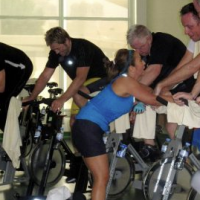We all strive for belonging. It’s a basic, even primitive need. It’s tribal. It has happened since the beginning of time.
Primitive people initially came together into communities for safety. Today our need for physical safety is not the same but the need for community persists. Over time we have learned that community also provides us with important emotional benefits: the sense of belonging to something, the sense of striving together toward a common purpose.
That feeling of belonging to a community is one of the most important attractions of indoor cycling.
Is it happening in your class? Would your class create a more powerful experience for your riders if it was?
How do you know if your class has community? We probably all think ours does. But some don’t.
Not every indoor cycling class becomes a community. Here are some tests:
- Do your class members happily interact with one another before and after class? Or do they just come and go? Do you see them together outside of the cycle studio?
- Do your class members see the class as all about the workout? Or do they expect some measure of thought and inspiration during class?
- Do your class members laugh together? Or, maybe, do they groan together when you ask for a particularly hard effort?
- Do your class members feel comfortable speaking up at appropriate times?
- Do your class members keep track of one another? Do they notice when a member has been gone for a couple of sessions?
Improvements are always possible even if you think your class is a high-functioning community. It helps to spend a few minutes thinking of your class from the perspective of community. If you better understand your class as a community, you can work your way toward some of the specific tools you can use to improve it.
Community isn’t something that just happens. All classes have the elements of time, music, and shared work. Those elements do help build community. But real community needs conscious nurturing and leadership from the instructor. The ability of the instructor to build community makes the difference between the mediocre class experience and the one that is memorable.
Community can be sensed when you walk in the room, but it is hard to define. To better understand community, it helps to think about some of its key principles. I’ve done some reading and thinking about community and I’ve come to believe that these are its key components: purpose, acceptance, work, consistency, and leadership. Let’s look at the ways you can foster these in your classes or studio to build the sense of community with your tribe.
Principles of Community


Great article Bill. Thanks for sharing.
Thsnks so much John. I know that you slso work at this in your classes.
I agree with everything you say in the article and strive to do this and improve all the time. Thanks for some new ideas, too. I like the partner DRILLS. That should be fun.
Hi Katy. Thanks for your comment. I got the partner encouragement drill idea from teaching a class for people with Parkinson’s disease. One of the symptoms of Parkinson’s is the closing down of vocal muscle. So it is best practice to encourage loud speech. I used the drill with them and liked it enough I now do it in many of my classes. Good luck with your classes. Thanks.
Great article, thank you
Thanks, Debbie. I think this is really crucial to what we do. I am happy if you found something that helped you.